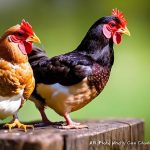Quails and chickens can be successfully raised together in a backyard setting, offering poultry keepers a diverse and interesting flock. Quails are small, gentle birds that produce eggs, while chickens are larger and commonly raised for both meat and egg production. Successfully keeping these two species together requires understanding their differences and making appropriate accommodations.
This includes considerations for housing, feeding, health management, and addressing behavioral aspects. Proper planning and care can result in a harmonious mixed flock, providing a unique and rewarding experience for poultry enthusiasts. Key factors to consider when raising quails and chickens together include coop design, feeding strategies, disease prevention, and managing social interactions between the two species.
Table of Contents
- 1 Understanding the Differences Between Quails and Chickens
- 2 Considerations for Housing Quails and Chickens Together
- 3 Feeding and Nutrition for Quails and Chickens
- 4 Health and Disease Management for Quails and Chickens
- 5 Behavioral Considerations when Keeping Quails and Chickens Together
- 6 Is Keeping Quails and Chickens Together Right for You?
- 7 FAQs
- 7.1 Can you keep quails and chickens together?
- 7.2 What are the benefits of keeping quails and chickens together?
- 7.3 Are there any potential issues with keeping quails and chickens together?
- 7.4 What should be considered when keeping quails and chickens together?
- 7.5 Can quails and chickens interbreed if kept together?
Key Takeaways
- Quails and chickens can be kept together, but it’s important to understand their differences and consider their housing, feeding, health, and behavioral needs.
- Quails are smaller and more delicate than chickens, so special care should be taken when housing them together to ensure their safety and well-being.
- When feeding quails and chickens together, it’s important to provide a balanced diet that meets the specific nutritional needs of each species.
- Regular health checks and disease management are crucial when keeping quails and chickens together to prevent the spread of diseases and ensure the overall well-being of the flock.
- Understanding the behavioral differences between quails and chickens is important for creating a harmonious environment, as they may have different social structures and communication methods.
Understanding the Differences Between Quails and Chickens
Size and Space Requirements
One of the most significant differences between quails and chickens is their size. Adult quails typically weigh between 4-6 ounces, while chickens can weigh anywhere from 5-10 pounds depending on the breed. This size difference means that quails are more vulnerable to being bullied or injured by larger chickens, so it’s crucial to provide adequate space and supervision to prevent any conflicts.
Housing and Environmental Needs
Quails and chickens have different housing and environmental needs. Quails are ground-dwelling birds that prefer to forage and nest on the ground, while chickens are more adept at perching and flying short distances. Therefore, the housing and environmental enrichment for quails and chickens should be tailored to their specific needs, with low roosting bars and plenty of ground cover for the quails, and higher perches and more vertical space for the chickens.
Behavioral Differences
Quails and chickens also exhibit different behaviors. Quails are generally more skittish and flighty compared to chickens, which are often more social and curious. Quails tend to startle easily and may be more prone to stress in certain situations, so it’s essential to provide them with hiding spots and quiet areas within the coop and run. Chickens, on the other hand, are more likely to investigate new objects or changes in their environment, which can sometimes lead to conflicts with the more timid quails.
By understanding these differences, poultry keepers can take steps to minimize stress and ensure that both quails and chickens feel comfortable and secure in their shared living space.
Considerations for Housing Quails and Chickens Together

When housing quails and chickens together, it is important to provide a coop and run that meets the needs of both species. The coop should have separate nesting areas for the quails and chickens, as well as low roosting bars for the quails and higher perches for the chickens. Additionally, the run should have plenty of ground cover for the quails to forage and dust bathe, as well as vertical space for the chickens to perch and explore.
It is also important to provide hiding spots and quiet areas within the coop and run for the quails to retreat to if they feel stressed or threatened. By providing these accommodations, poultry keepers can create a harmonious living environment for both quails and chickens. Another important consideration for housing quails and chickens together is predator protection.
Quails are particularly vulnerable to predation due to their small size and ground-dwelling nature, so it is essential to secure the coop and run with sturdy wire mesh to prevent entry by predators such as rats, snakes, and birds of prey. Additionally, providing a secure roof over the run can help protect both quails and chickens from aerial predators. By taking these precautions, poultry keepers can ensure the safety and well-being of their mixed flock.
Feeding and Nutrition for Quails and Chickens
Feeding a mixed flock of quails and chickens requires careful consideration of their dietary needs. While both quails and chickens require a balanced diet of protein, carbohydrates, vitamins, and minerals, there are some differences in their nutritional requirements that should be taken into account. Quails have a higher protein requirement compared to chickens, especially during periods of egg production, so it is important to provide them with a high-quality game bird or turkey starter feed that contains at least 24% protein.
Additionally, quails benefit from access to live insects such as mealworms or crickets as a source of supplemental protein. Chickens, on the other hand, can thrive on a lower protein diet of around 16-18%, which is typically found in standard layer feeds. However, it is important to monitor the protein content of the feed when keeping quails and chickens together to ensure that the quails’ nutritional needs are being met.
Providing separate feeding stations for the quails and chickens can help prevent competition for food and ensure that each bird receives the appropriate nutrition. Additionally, offering oyster shell or crushed eggshells free-choice can provide supplemental calcium for both quails and laying hens. By carefully managing the feeding and nutrition of a mixed flock, poultry keepers can support the health and productivity of both quails and chickens.
Health and Disease Management for Quails and Chickens
Maintaining the health of a mixed flock of quails and chickens requires proactive disease management and biosecurity measures. Quails are known to be more susceptible to certain diseases such as coccidiosis, so it is important to keep their living environment clean and dry to minimize the risk of infection. Additionally, providing a separate dust bathing area with sand or diatomaceous earth can help control external parasites such as mites and lice that may affect both quails and chickens.
Chickens are also susceptible to a range of diseases such as Marek’s disease, infectious bronchitis, and avian influenza, so it is important to practice good biosecurity measures such as limiting exposure to wild birds, quarantining new birds before introducing them to the flock, and regularly disinfecting feeders, waterers, and equipment. Monitoring the health of both quails and chickens on a regular basis can help identify any signs of illness or distress early on, allowing for prompt intervention and treatment if necessary. In addition to disease management, providing access to clean water at all times is essential for maintaining the health of a mixed flock.
Quails are particularly sensitive to dehydration due to their small size, so it is important to ensure that they have easy access to water at all times. Regularly cleaning and refilling waterers can help prevent the spread of disease and ensure that both quails and chickens remain well-hydrated. By implementing these health management practices, poultry keepers can support the overall well-being of their mixed flock.
Behavioral Considerations when Keeping Quails and Chickens Together

Providing a Safe and Secure Environment
Quails are known for their skittish nature and tendency to startle easily, so it is essential to provide them with hiding spots and quiet areas within the coop and run where they can retreat if they feel stressed or threatened. Additionally, providing plenty of ground cover such as shrubs or tall grass can help create a sense of security for the quails while also providing opportunities for foraging and dust bathing.
Managing Interactions and Reducing Conflicts
Chickens are generally more social and curious compared to quails, so they may be more likely to investigate new objects or changes in their environment. This can sometimes lead to conflicts with the more timid quails, so it is important to monitor their interactions closely and intervene if necessary. Providing multiple feeding stations and waterers can help prevent competition for resources and reduce the likelihood of conflicts between quails and chickens.
Environmental Enrichment for a Harmonious Flock
By understanding these behavioral considerations, poultry keepers can create a peaceful and enriching living environment for both quails and chickens. Quails benefit from access to low roosting bars, hiding spots, dust bathing areas, and plenty of ground cover for foraging. Chickens, on the other hand, enjoy perching on higher roosts, scratching in litter or bedding material, dust bathing in dry soil or sand, and exploring their surroundings. By providing these enriching elements within the coop and run, poultry keepers can support the natural behaviors of both quails and chickens while also minimizing stress and conflicts.
Is Keeping Quails and Chickens Together Right for You?
Keeping quails and chickens together can be a rewarding experience for poultry enthusiasts who are willing to make the necessary accommodations for both species. By understanding the differences between quails and chickens in terms of size, behavior, housing needs, feeding requirements, health management, and environmental enrichment, it is possible to create a harmonious living environment for both species. However, it is important to carefully consider whether keeping quails and chickens together is right for you based on your available space, resources, time commitment, and willingness to meet the specific needs of each species.
If you are considering keeping quails and chickens together, it is essential to provide adequate space in the coop and run, separate nesting areas, appropriate feeding stations, predator protection measures, disease management practices, environmental enrichment elements, and regular monitoring of their interactions. By taking these considerations into account, poultry keepers can create a peaceful and enriching living environment for both quails and chickens while also enjoying the benefits of a diverse flock. Ultimately, keeping quails and chickens together requires careful planning, attention to detail, and a genuine commitment to meeting the needs of both species in order to ensure their health, well-being, and overall happiness in a shared living space.
If you’re considering keeping quails and chickens together, you may also be interested in learning about how to design the interior of your chicken coop to accommodate both species. Check out this article on chicken coop interior ideas for tips on creating a space that is suitable for both quails and chickens.
FAQs
Can you keep quails and chickens together?
Yes, it is possible to keep quails and chickens together in the same coop or enclosure.
What are the benefits of keeping quails and chickens together?
Keeping quails and chickens together can provide companionship for the birds and can also help in maximizing space and resources.
Are there any potential issues with keeping quails and chickens together?
There can be potential issues with keeping quails and chickens together, such as differences in dietary needs and potential aggression between the two species.
What should be considered when keeping quails and chickens together?
When keeping quails and chickens together, it is important to provide separate feeding and watering areas to accommodate their different dietary needs. Additionally, providing enough space and monitoring for any signs of aggression is important.
Can quails and chickens interbreed if kept together?
Quails and chickens are not able to interbreed if kept together, as they are different species with different mating behaviors and reproductive systems.
Meet Walter, the feathered-friend fanatic of Florida! Nestled in the sunshine state, Walter struts through life with his feathered companions, clucking his way to happiness. With a coop that’s fancier than a five-star hotel, he’s the Don Juan of the chicken world. When he’s not teaching his hens to do the cha-cha, you’ll find him in a heated debate with his prized rooster, Sir Clucks-a-Lot. Walter’s poultry passion is no yolk; he’s the sunny-side-up guy you never knew you needed in your flock of friends!








